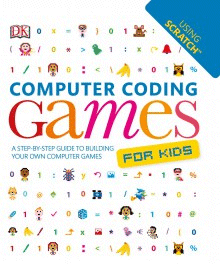Computer Coding Games for Kids
Jon Woodcock
Dorling Kindersley, 2016
224pp., pbk., RRP $A35.00
9781740333405
Way back when, in the dawning of the age of home computers which were huge and clumsy in comparison to today’s mini-marvels; which ran on cassette tapes; had green or amber font on a black screen and had no facility to display graphics, if you wanted to play a game you bought a book of instructions and carefully tapped the commands in, one keystroke at a time. It was the realm of the real computer nerd and if you were patient and precise, eventually you got to play the most basic of games.
Fast forward 30+ years and now our kids have computers in their pockets, on their wrists and even in their clothes. And with the increased focus on science, technology, engineering and maths once again the red-hot buzzword in schools is ‘coding’ as students learn not to program a clumsy turtle that only went backwards, forwards and sideways, but to create and develop their own games to play, some in the hope that theirs will be even bigger than Pokémon Go!
But no longer do they have to sit in solitary confinement painstakingly tap, tap, tapping. These days, the most commonly used development tool is Scratch™ https://scratch.mit.edu/, a free program which “helps young people learn to think creatively, reason systematically, and work collaboratively — essential skills for life in the 21st century”, and Dorling Kindersley have produced what might be the beginners’ bible in learning how to create a computer game. Not for them the single volume, monochrome “pamphlet” that crossed your eyes just looking at it – this is a beautifully presented, full colour, step-by-step guide presented in the typical DK layout that is so user-friendly. Beginning with an introduction that describes what makes a good game, the types of games and how coding works, it moves on to introducing Scratch, accessing it and then straight into making a basic game, eventually moving on to more and more complex tasks and challenges.
Fifteen years ago I went to computer classes and tried very hard to make a cow jump over the moon using a program Macromedia Flash™. Night after night it absorbed me until I gave up in defeat and despair – clearly I just didn’t have the brain for it. So to test out Computer Coding Games for Kids I read through the introductory chapters, accessed Scratch™ and had a go at the first project – Star Hunter, “a fast-paced underwater treasure hunt.” In just seven quick steps I had a cat that followed my mouse all around the screen and was ready to build the next part of the game. WINNER! If I can do it, anyone can! So when the curriculum requires students to have a basic knowledge of coding, this has to be the go-to book for teachers and students. Even the most confirmed luddite will succeed and the students will be having such fun as they read and follow instructions and learn without realising it that ‘coding’ will become a key part of the school day!
In fact this book was going to be a donation to a school library I know but I think I will keep it because I can see hours of fun ahead for Miss 10 and Miss 5 and me on the wintery days yet to come for us and even those when it’s too hot to go outside. Who knows, we may be the creators of the next Pokémon Go!
